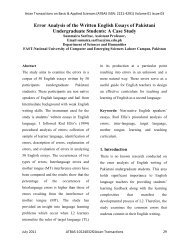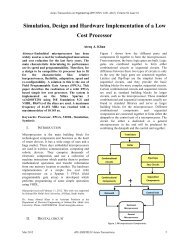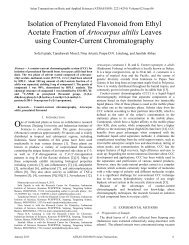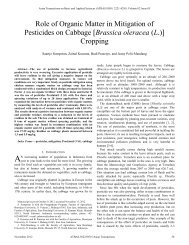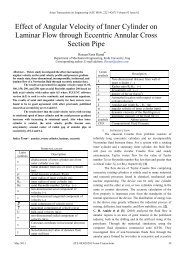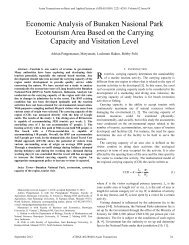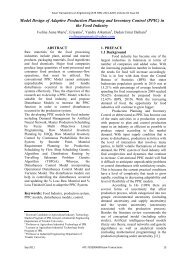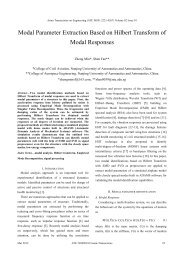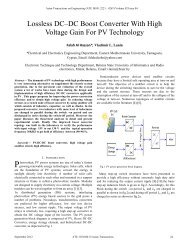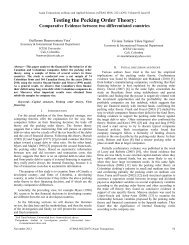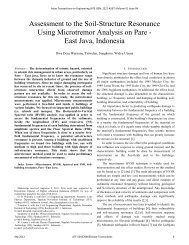CFD Prediction of Stratified Oil-Water Flow in a Horizontal Pipe
CFD Prediction of Stratified Oil-Water Flow in a Horizontal Pipe
CFD Prediction of Stratified Oil-Water Flow in a Horizontal Pipe
You also want an ePaper? Increase the reach of your titles
YUMPU automatically turns print PDFs into web optimized ePapers that Google loves.
Asian Transactions on Eng<strong>in</strong>eer<strong>in</strong>g (ATE ISSN: 2221-4267) Volume 01 Issue 05horizontal wells <strong>in</strong> order to assist <strong>in</strong> measur<strong>in</strong>g the oil andwater flow rates.Hui et al [10] simulated stratified oil–water two-phaseturbulent flow <strong>in</strong> a horizontal tube numerically us<strong>in</strong>g a volume<strong>of</strong> fluid model. They applied RNG k–ε model comb<strong>in</strong>ed with anear-wall low-Re turbulence model to each phase, and theyadopt cont<strong>in</strong>uum surface force approximation for thecalculation <strong>of</strong> surface tension. They performed a timedependentsimulation and they analyzed f<strong>in</strong>al solution whichcorresponds to steady-state flow. They reported that theirresults <strong>of</strong> pressure loss, slip ratio, local phase fraction pr<strong>of</strong>ileand the axial velocity pr<strong>of</strong>ile are verified by experimental data<strong>in</strong> literature.Awal et al [4] achieved <strong>CFD</strong> simulation tool to <strong>in</strong>vestigate<strong>in</strong>l<strong>in</strong>e oil and water separation characteristics under downholeconditions. Specifically, they <strong>in</strong>vestigated the startl<strong>in</strong>gsensitivity <strong>of</strong> well <strong>in</strong>cl<strong>in</strong>ation <strong>in</strong> the 80-100 degrees range.They chose the Eulerian-Eulerian model, which iscomputationally most comprehensive but more suitable formultiphase systems with the dispersed phase exceed<strong>in</strong>g 10%v/v. The base case model for their <strong>CFD</strong> simulation study was ahorizontal well. They run the problem <strong>in</strong> 3D us<strong>in</strong>g the standardk-ε turbulence model. They simulated oil (μ= 2.3 cp, ρ=850kg/m 3 ) and water flow<strong>in</strong>g <strong>in</strong> 6.3 <strong>in</strong> ID well.Carlos F. [7] developed a 2D model for fully-developed,turbulent-turbulent oil-water stratified flow. The model isbased on a numerical solution <strong>of</strong> the basic govern<strong>in</strong>gdifferential equations us<strong>in</strong>g a f<strong>in</strong>ite-volume method <strong>in</strong> abipolar coord<strong>in</strong>ate system, apply<strong>in</strong>g a simple mix<strong>in</strong>g-lengthturbulence model. In addition, he presented a modifiedturbulent diffusion model. He tested and compared his multifluidmodel, <strong>in</strong>corporated <strong>in</strong> the commercial <strong>CFD</strong> codeFLUENT, with oil-water dispersed flow data.De-Sampaio et .al [9] reported numerical and experimental<strong>in</strong>vestigation <strong>of</strong> stratified gas–liquid two-phase flow <strong>in</strong>horizontal circular pipes. They simulated Reynolds averagedNavier–Stokes equations (RANS) with the k–ω turbulencemodel for a fully developed stratified gas–liquid twophaseflow. They assumed smooth <strong>in</strong>terface surface withoutconsider<strong>in</strong>g the effects <strong>of</strong> the <strong>in</strong>terfacial waves. Based on theircomparison <strong>of</strong> the numerical results with experimental results,they reported that the k–ω model can be applied for thenumerical simulation <strong>of</strong> stratified gas–liquid two-phase flow.Rashmi et al [13] <strong>in</strong>vestigated numerically, us<strong>in</strong>gcommercial <strong>CFD</strong> package FLUENT 6.2 <strong>in</strong> conjunction withmultiphase model, the three-dimensional dispersed flow <strong>of</strong><strong>Oil</strong>-water <strong>in</strong> a horizontal pipe (ID=0.0024 m). They used k-εmodel to describe the turbulence <strong>in</strong> cont<strong>in</strong>uous phase. Theyreported numerical results <strong>in</strong> terms <strong>of</strong> the phase distributionpr<strong>of</strong>iles and average <strong>in</strong>-situ hold-up. They argued that theirpredicted results were seen to be <strong>in</strong> good agreementqualitatively as well as quantitatively with experimental resultsavailable <strong>in</strong> the literature.The ma<strong>in</strong> focus <strong>of</strong> the present study is on the numericaldeterm<strong>in</strong>ation <strong>of</strong> the oil-water stratified flow pattern us<strong>in</strong>g<strong>CFD</strong> model<strong>in</strong>g. The segregated flow is simulated us<strong>in</strong>g VOFmultiphase with RNG-k-ε turbulent models and compared withthose flow pattern monitored experimentally by Al-Yaari, et al[1].II. MATHEMATICAL MODELThe commercial FLUENT s<strong>of</strong>tware package, FLUENT 6.2,was used for solv<strong>in</strong>g the set <strong>of</strong> govern<strong>in</strong>g equations. Thenumerical method employed is based on the f<strong>in</strong>ite volumeapproach (Fluent, 2001). Fluent provides flexibility <strong>in</strong>choos<strong>in</strong>g discretization schemes for each govern<strong>in</strong>g equation.The discretized equations, along with the <strong>in</strong>itial condition andboundary conditions, were solved us<strong>in</strong>g the segregatedsolution method to obta<strong>in</strong> a numerical solution.The Volume <strong>of</strong> Fluid (VOF) model is employed to predictthe oil–water stratified flow behavior <strong>in</strong> a 0.0254 m horizontalpipe. In the VOF method, two phases are modeled as twoseparated phases.In the region near the wall, the gradient <strong>of</strong> quantities isconsiderably high and requires f<strong>in</strong>e grids close to the wall tocapture the change <strong>of</strong> quantities. This causes the calculation tobecome more expensive mean<strong>in</strong>g time-consum<strong>in</strong>g, requir<strong>in</strong>ggreater memory and faster process<strong>in</strong>g on the computer, as wellas expensive <strong>in</strong> terms <strong>of</strong> complexity <strong>of</strong> equations. A wallfunction, which is a collection <strong>of</strong> semi-empirical formulas andfunctions, provides a cheaper calculation by substitut<strong>in</strong>g thef<strong>in</strong>e grids with a set <strong>of</strong> equations l<strong>in</strong>k<strong>in</strong>g the solutions‘variables at the near-wall cells and the correspond<strong>in</strong>gquantities on the wall.A. GeometryIII. NUMERICAL SOLUTIONFigure 1 & 2 show a photograph and schematic layout <strong>of</strong> theexperimental setup, respectively. The flow patterns <strong>of</strong> twophaseflow <strong>in</strong> a straight-tube depend on different parameterssuch as diameter, pipe roughness, pipe material, velocity,physical properties, …etc (Al-Yaari et al [1]).A sketch <strong>of</strong> the geometry <strong>of</strong> the calculation doma<strong>in</strong> is shown<strong>in</strong> Figure 3. The geometry consists <strong>of</strong> three parts, i.e. the oil<strong>in</strong>let pipe, the water <strong>in</strong>let pipe and the acrylic test section. Thelength <strong>of</strong> the oil and water <strong>in</strong>let pipes is 30 Cm (11.8 times thediameter <strong>of</strong> the pipe). The test section (acrylic pipe) is 2.2 m.The diameter <strong>of</strong> the pipe for the present work is 0.0254 m.The computational grid <strong>of</strong> 63,493, 82,933, 104,533 and147,733 cells were generated and used for the mesh<strong>in</strong>dependent study to f<strong>in</strong>d out the optimum size <strong>of</strong> the mesh.The grid was generated us<strong>in</strong>g Gambit 2.2, which is compatiblewith Fluent 6.2.A boundary layer, which conta<strong>in</strong>s four cells with a distance<strong>of</strong> the cell adjacent to the wall at 1 mm, and the growth factor<strong>of</strong> 1.2, is employed on the wall to improve the performance <strong>of</strong>the wall function and to fulfill the requirement <strong>of</strong> y + , thedimensionless wall distance, for the cell adjacent to the wallNov 2011 ATE-80112059©Asian-Transactions 69
Asian Transactions on Eng<strong>in</strong>eer<strong>in</strong>g (ATE ISSN: 2221-4267) Volume 01 Issue 05which is <strong>in</strong> the range 50–500 (Fluent, 2001).. Thedimensionless distance y + is def<strong>in</strong>ed by:y u To obta<strong>in</strong> better convergence and accuracy for a long pipe,the hexagonal shape and Cooper-type elements have beenemployed. The Cooper-type element is a volume mesh<strong>in</strong>g type<strong>in</strong> Gambit, which uses an algorithm to sweep the mesh nodepatterns <strong>of</strong> specified ‗source‘ faces through the volume.The space doma<strong>in</strong> for the <strong>CFD</strong> analysis refers to 0.0254 mID pipe. A three-dimensional mesh has been set up, by add<strong>in</strong>gfurther volumes test section.ypFigure 3 Mesh systems for the circular cross-sectional pipe test sectionB. Boundary ConditionsThere are three faces bound<strong>in</strong>g the calculation doma<strong>in</strong>: the<strong>in</strong>let boundary, the wall boundary and the outlet boundary. Flatvelocity pr<strong>of</strong>ile for oil and water were <strong>in</strong>troduced at the <strong>in</strong>let <strong>of</strong>their sections. The outlet boundary condition <strong>of</strong> the latter wasset up as a pressure outlet boundary. No slip was used tomodel liquid velocity at the wall.The ma<strong>in</strong> fluid phases‘ physical properties are reported <strong>in</strong>Table 1.Table 1 Ma<strong>in</strong> physical properties for the fluid phasesFigure 1 Photograph <strong>of</strong> the flow loopProperty <strong>Water</strong> Phase <strong>Oil</strong> PhaseDensity (ρ), kg/m 3 998.2 780Dynamic Viscosity (μ),Pa.s0.001003 0.00157Interfacial Tension,N/m0.017 N/m @ 20°CFigure 2 Schematic layout <strong>of</strong> the flow loopC. Solution Strategy & ConvergenceWhile Presto discretization scheme was used for pressure,first order upw<strong>in</strong>d discretization scheme was used for themomentum equation volume fraction, turbulent, k<strong>in</strong>etic andturbulent dissipation energy. These schemes ensured, <strong>in</strong>general, satisfactory accuracy, stability and convergence. Inaddition, the steady-state solution strategy was employed.The convergence criterion is based on the residual value <strong>of</strong>the calculated variables, i.e. mass, velocity components,turbulent k<strong>in</strong>etic energies, turbulent dissipation energies andvolume fraction. In the present calculations, the thresholdvalues were set to a hundred thousandth for cont<strong>in</strong>uity and athousandth for the rema<strong>in</strong><strong>in</strong>g equations. These values areconsidered small enough to produce accurate results.Nov 2011 ATE-80112059©Asian-Transactions 70
Asian Transactions on Eng<strong>in</strong>eer<strong>in</strong>g (ATE ISSN: 2221-4267) Volume 01 Issue 05Other solution strategies are: the reduction <strong>of</strong> underrelaxationfactors <strong>of</strong> momentum, volume fraction, turbulencek<strong>in</strong>etic energy and turbulence dissipation energy to br<strong>in</strong>g thenon-l<strong>in</strong>ear equation close to the l<strong>in</strong>ear equation, subsequentlyus<strong>in</strong>g a better <strong>in</strong>itial guess based on a simpler problem.IV. EXPERIMENTAL & SIMULATION RESULTSIn this section one presents, compares and discusses theexperimental and numerical data.A. Experimental <strong>Oil</strong>-<strong>Water</strong> <strong>Flow</strong> PatternsThe flow pattern was observed for a wide range <strong>of</strong> mixturevelocities (0.5 m/s to 3.5 m/s) and <strong>in</strong>put water volume fractionrange <strong>of</strong> (0.1 to 0.9). This observation was made at 1.1 m fromthe <strong>in</strong>let <strong>of</strong> the test section. A variety <strong>of</strong> flow patterns wereformed <strong>in</strong> co-current flow <strong>of</strong> oil and water <strong>in</strong> the acrylic testsection. In general, the flow pattern map depends on thegeometry, liquid physical properties and wett<strong>in</strong>g properties <strong>of</strong>the wall surface. The flow pattern classification was based onvisual observation and does not necessarily represent uniquehydrodynamic characteristics. Figure 4 shows the flow patternsobserved which are def<strong>in</strong>ed as follows:I. <strong>Stratified</strong> wavy flow (SW). The phases are completelysegregated with the <strong>in</strong>terface between them show<strong>in</strong>g acharacteristic wavy nature.II. <strong>Stratified</strong> wavy / drops (SWD). The entra<strong>in</strong>ment <strong>of</strong> oneor both phases as drops <strong>in</strong> the other has begun, the dropletsbe<strong>in</strong>g concentrated near the <strong>in</strong>terface zone (stratified wavywith mix<strong>in</strong>g <strong>in</strong>terface).III. <strong>Stratified</strong> mixed / water layer (SMW). There are twolayers <strong>in</strong> the flow: a lower clear water layer and an upperlayer which can be oil cont<strong>in</strong>uous conta<strong>in</strong><strong>in</strong>g a dispersion<strong>of</strong> water droplets or water cont<strong>in</strong>uous conta<strong>in</strong><strong>in</strong>g adispersion <strong>of</strong> oil droplets or a comb<strong>in</strong>ation <strong>of</strong> the two.IV. <strong>Stratified</strong> mixed / oil layer (SMO). There are two layers<strong>in</strong> the flow: an upper clear oil layer and a lower layerwhich can be oil cont<strong>in</strong>uous conta<strong>in</strong><strong>in</strong>g a dispersion <strong>of</strong>water droplets or water cont<strong>in</strong>uous conta<strong>in</strong><strong>in</strong>g a dispersion<strong>of</strong> oil droplets or a comb<strong>in</strong>ation <strong>of</strong> the two.V. Three layers flow. There are clear oil and water layers atthe top and bottom <strong>of</strong> the pipe respectively with adispersed layer between them.VI. Dispersed flow. One phase is completely dispersed asdroplets <strong>in</strong> the other. The cont<strong>in</strong>uous phase changes fromone fluid to the other at the phase <strong>in</strong>version po<strong>in</strong>t.The resultant flow pattern data for oil-water are plotted <strong>in</strong>Figure 5 <strong>in</strong> terms <strong>of</strong> <strong>in</strong>put water volume fraction aga<strong>in</strong>stsuperficial mixture velocity. As illustrated <strong>in</strong> this figure, thestratified flow pattern was observed for the whole exam<strong>in</strong>edrange <strong>of</strong> the <strong>in</strong>put water volume fraction at a very lowsuperficial mixture velocity (0.5 m/s). As the mixture velocity<strong>in</strong>creased to 1 m/s, the stratified flow pattern changed tostratified wavy with drops, three layers and stratifiedmixed/water layer flow patterns successively with <strong>in</strong>creas<strong>in</strong>gwater fraction at <strong>in</strong>put water volume fraction <strong>of</strong> 0.35, 0.55 and0.75 respectively. Numerical study will focus on such type <strong>of</strong>flow pattern; i.e., stratified flow pattern.Figure 4 <strong>Oil</strong>-water flow patterns <strong>in</strong> a horizontal pipe with 0.0254 m IDB. Model SelectionFigure 5 <strong>Flow</strong> pattern map <strong>of</strong> oil-water flowDifferent multiphase models (VOF, Mixture and Eularian)were tested to model the oil water stratified flow pattern. Inaddition different turbulent models (RNG-k-ε, Releazable- k-ε,RSM, and SA) have been adopted to figure out the bestselection to be used to simulate oil-water stratified flow <strong>in</strong> ahorizontal pipe. RSM (1) and RSM (2), <strong>in</strong> Figure 7 below,Nov 2011 ATE-80112059©Asian-Transactions 71
Asian Transactions on Eng<strong>in</strong>eer<strong>in</strong>g (ATE ISSN: 2221-4267) Volume 01 Issue 05represent the turbulent model without and with def<strong>in</strong><strong>in</strong>g the<strong>in</strong>terfacial tension between oil and water respectively. RNG(1) and RNG (2), <strong>in</strong> Figure 8 below, represent the turbulent k-εmodel with standard and enhanced wall function respectively.Before mak<strong>in</strong>g selection, all models oil volume fractionresults should be at an x-section where the flow is fullydeveloped. Static pressure plot at the centerl<strong>in</strong>e <strong>of</strong> the testsection (<strong>in</strong> x-direction) is presented <strong>in</strong> Figure 6 below. Basedon that, x=-1.4 m section was made.For the coarse mesh, all <strong>of</strong> the models fail to predict thestratified flow pattern as presented for some <strong>of</strong> them <strong>in</strong> Figure7 below. This can be attributed to that the mesh was not f<strong>in</strong>eenough to predict the oil-water stratified flow pattern.However, for f<strong>in</strong>er meshes, while almost all the models predictthe clearly separated oil layer, they do fail to predict clearlywater separated layer and this problem should be figured outbefore simulat<strong>in</strong>g other flow patterns presented <strong>in</strong> Figure 5.Based on the time required for convergence to occur andliterature and Fluent recommendations, VOF multiphasemodel with RNG-k-ε model has been selected to achieve thesimulation.Figure 8 <strong>Oil</strong> volume fraction contours at x=-1.4 m (for f<strong>in</strong>er mesh)Figure 6 Pressure plot at the test section centerl<strong>in</strong>e <strong>in</strong> the flowdirectionC. Mesh Independent StudyThe computational grid <strong>of</strong> 63,493, 82,933, 104,533 and147,733 cells were tested for the mesh <strong>in</strong>dependent study t<strong>of</strong><strong>in</strong>d out the optimum size <strong>of</strong> the mesh to be used forsimulation. <strong>Oil</strong> volume fraction contours at plane x=-1.4 m arepresented <strong>in</strong> Figure 9 below.As shown <strong>in</strong> this figure, system with 63,493 and 82,933 cellsalmost predict the same oil fractions with differences <strong>in</strong> thesmoothness <strong>of</strong> the clearly oil and mixed layer. However, s<strong>in</strong>ce63,493 cells was bad while predict<strong>in</strong>g the stratified flowpattern at other water volume fraction, extra number <strong>of</strong> cellsare needed to be tested. Fortunately, system with 104,533 and147,733 cells give the same oil volume fraction contours atx=-1.4 m. Therefore, based on the oil volume fraction contoursresults, 104,533 cells are the optimum number <strong>of</strong> cellsrequired to predict the oil-water stratified flow <strong>in</strong> the testeddoma<strong>in</strong> and such mesh is go<strong>in</strong>g to be used while simulation.In addition, such decision has been tested with compar<strong>in</strong>gstatic pressure contours at x=-1.4 m for all the four testednumber <strong>of</strong> cells. Static pressure contours <strong>of</strong> all tested cases arepresented <strong>in</strong> Fig. 10 below. As shown <strong>in</strong> that figure, the staticpressures at x=-1.4 m were 437, 437, 465 and 465 Pa for63,493, 82,933, 104,533 and 147,733 cells respectively. Suchresults support the previous results and decision.Figure 7 <strong>Oil</strong> volume fraction contours at x=-1.4 m (for the coarse mesh)Nov 2011 ATE-80112059©Asian-Transactions 72
Asian Transactions on Eng<strong>in</strong>eer<strong>in</strong>g (ATE ISSN: 2221-4267) Volume 01 Issue 05Volume <strong>of</strong> fluid (VOF) multiphase model with RNG-k-εmodel was used for simulation the tested doma<strong>in</strong> conta<strong>in</strong><strong>in</strong>g104,533 cells (the optimum mesh size) based on the decisionmentioned earlier <strong>in</strong> this paper. For this case, s<strong>in</strong>ce waterfraction is very low, <strong>in</strong>itializ<strong>in</strong>g with 1 water fraction is thebest to get convergence. In addition, 2% turbulence <strong>in</strong>tensitywas used s<strong>in</strong>ce the flow if stratified way as observedexperimentally (Al-Yaari, et al [1]).The oil volume fraction contours are presented <strong>in</strong> Figure 11below. As shown <strong>in</strong> this figure, clearly separated oil layer witha wavy <strong>in</strong>terface (stratified wavy flow pattern) was predictedby <strong>CFD</strong> simulation and this match<strong>in</strong>g results reported by Al-Yaari, et al [1]. On the other hand, separated water layer wasnot predicted completely. Therefore, much effort should be putto solve such problem.Figure 9 <strong>Oil</strong> volume fraction contours at x=-1.4 m for mesh sizesD. Some <strong>CFD</strong> Results for One Case StudyThe oil-water stratified flow pattern at oil-water mixturevelocity <strong>of</strong> 1 m/s, 0.85 oil velocity and 0.15 water velocity(0.15 <strong>in</strong>put water volume fraction) as a sample flow patternhas been simulated. At such condition, the oil-water flowpattern is stratified (See Figure 5).Figure 11 <strong>Oil</strong> volume fraction contours at x=-1.4 m for the optimummesh sizeFigure 10 Static pressure contours at x=-1.4 m for mesh sizesFigure 12 (a) Mixture velocity vectors at x=-1.4 m for theoptimum mesh size(b) Mixture velocity contours at x=-1.4 m for theoptimum mesh sizeNov 2011 ATE-80112059©Asian-Transactions 73
Asian Transactions on Eng<strong>in</strong>eer<strong>in</strong>g (ATE ISSN: 2221-4267) Volume 01 Issue 05Furthermore, the oil-water mixture vectors and contours atx=-1.4 m are presented <strong>in</strong> Figure 12 above. As shown <strong>in</strong> suchfigure, the no slip condition on wall was applied and mixturevelocity <strong>in</strong>creases with decreas<strong>in</strong>g the radius <strong>of</strong> the flow area.V. CONCLUSIONSThe follow<strong>in</strong>g conclusive remarks result from our analysis.As far as the fluid dynamic analysis is concerned:1. <strong>CFD</strong> calculations us<strong>in</strong>g Fluent 6.2 were performed topredict the oil-water stratified flow <strong>in</strong> 0.0254 mhorizontal pipe.2. Volume <strong>of</strong> fluid (VOF) multiphase model with RNGk-εtwo equations turbulent model was selectedamong other different multiphase and turbulentmodels based on the convergence, prediction <strong>of</strong> theoil-water stratified flow pattern and the smoothness <strong>of</strong>the <strong>in</strong>terface.3. Care should be taken while <strong>in</strong>itializ<strong>in</strong>g the <strong>CFD</strong>solver to obta<strong>in</strong> convergence.4. Mesh <strong>in</strong>dependent study has been achieved to decideon the optimum mesh size to be used <strong>in</strong> thesimulation process.5. Some results <strong>of</strong> the <strong>CFD</strong> simulation for one casestudy, where the stratified oil-water flow pattern wasobserved experimentally by Al-Yaari, et al [1].6. While the clearly separated oil layer and the wavy<strong>in</strong>terface <strong>of</strong> oil-water system were predicted well by<strong>CFD</strong> simulation, clearly separated water layer was notpredicted completely. Therefore, such problemshould be solved before simulate other stratifiedpo<strong>in</strong>ts.ACKNOWLEDGMENTAuthors are also grateful for useful discussions with Dr.Rached Ben-Mansour <strong>of</strong> Mechanical Eng<strong>in</strong>eer<strong>in</strong>g Department,K<strong>in</strong>g Fahd University <strong>of</strong> Petroleum & M<strong>in</strong>erals, Dhahran,Saudi Arabia.REFERENCES[1] Al-Yaari, M., Abu-Sharkh, B., Soleimani, A., Al-Mubayeidh, U. and Al-Sarkhi, A. ―Effect <strong>of</strong> DragReduc<strong>in</strong>g Polymers on <strong>Oil</strong>-<strong>Water</strong> <strong>Flow</strong> <strong>in</strong> a <strong>Horizontal</strong><strong>Pipe</strong>‖, International Journal <strong>of</strong> Multiphase <strong>Flow</strong>, 2009,35, 516–524.[2] Angeli, P., ―Liquid-Liquid Dispersed <strong>Flow</strong>s <strong>in</strong> <strong>Horizontal</strong><strong>Pipe</strong>s‖, PhD Thesis, Imperial College, University <strong>of</strong>London, 1997.[3] Arirachakaran, S., Oglesby, K. D., Mal<strong>in</strong>owsky, M. S.,Shoham, O. and Brill, J. P. ―An analysis <strong>of</strong> oil/water flowphenomena <strong>in</strong> horizontal pipes‖, SPE ProductionOperations Symposium, Oklahoma, 1989, March 13-14,SPE 18836.[4] Awal, Mohammad R., Zughbi, Habib D., Razzak, ShaikhA., Al-Majed, Abdulaziz A., and Al-Yousef, Hasan Y.,―Liquids phase holdup and separation characteristics as afunction <strong>of</strong> well <strong>in</strong>cl<strong>in</strong>ation and flowrate‖, SPE SA, 2005,14-16 May.[5] Brauner, N. and Maron, D.M. ―Two-phase liquid-liquidstratified flow‖, PhysicoChem. Hydrodynamics, 1989,11(4), 487-506.[6] Brauner, N. and Moalem Maron. D., ―Stability analysis <strong>of</strong>stratified liquid-liquid flow‖, Int. J. Multiphase <strong>Flow</strong>,1992, 18(1), 103-121.[7] Carlos F. ―Modell<strong>in</strong>g <strong>of</strong> oil-water flow <strong>in</strong> horizontal andnear horizontal pipes‖, PhD Thesis, Tulsa University,2006.[8] Charles, M.E., Govier, G.W., Hodgson, G.W. ―Thehorizontal pipel<strong>in</strong>e flow <strong>of</strong> equal density oil-watermixtures‖, Can. J. Chemical Eng<strong>in</strong>eer<strong>in</strong>g, 1961, 39, 27-36.[9] De Sampaio, Paulo, Facc<strong>in</strong>i, Jose´ and Su, Jian,―Modell<strong>in</strong>g <strong>of</strong> stratified gas–liquid two-phase flow <strong>in</strong>horizontal circular pipes‖, International Journal <strong>of</strong> Heatand Mass Transfer, 2008, 51, 2752–2761.[10] Hui Gao, Han-Yang Gu and Lie-J<strong>in</strong> Guo, ―Numericalstudy <strong>of</strong> stratified oil–water two-phase turbulent flow <strong>in</strong> ahorizontal tube‖, International Journal <strong>of</strong> Heat and MassTransfer, 2003, 46, 749–754.[11] Kurban, A., Angeli, P., Mendes-Tatsis, M. and Hewitt, G.―<strong>Stratified</strong> and dispersed oil-water flows <strong>in</strong> horizontalpipes‖, 7 th International Conference on MultiphaseProduction, Cannes, France, 1995, 277-291.[12] Oglesby, K. ―An experimental study on the effects <strong>of</strong> oilviscosity, mixture velocity, and water fraction on horizontaloil-water flow‖, M.S. Thesis, U. Tulsa, 1979.[13] Rashmi G. Walvekar, Thomas S.Y. Choong, S.A.Hussa<strong>in</strong>, M. Khalid and T.G. Chuah, ―Numerical study <strong>of</strong>dispersed oil–water turbulent flow <strong>in</strong> horizontal tube‖,Journal <strong>of</strong> Petroleum Science and Eng<strong>in</strong>eer<strong>in</strong>g, 2009, 65,123–128.[14] Russell, T., Hodgson, G. and Govier, G. ―<strong>Horizontal</strong>pipel<strong>in</strong>e flow <strong>of</strong> mixtures <strong>of</strong> oil and water‖, Canadian J.Chemical Eng<strong>in</strong>eer<strong>in</strong>g, February 1959, 37, 9-17.[15] Shi, H., Cai, J. and Jepson, W. ―<strong>Oil</strong>-water two-phase flows<strong>in</strong> large-diameter pipel<strong>in</strong>es‖, ASME Transactions, J. <strong>of</strong>Energy Resources Technology, 2001, 123(4), 270-276.[16] Soleimani, A., ―Phase distribution and associatedphenomenon <strong>in</strong> oil-water flows <strong>in</strong> horizontal tube‖, PhDThesis, Imperial College, University <strong>of</strong> London, 1999.[17] Theron, B.E. and Unw<strong>in</strong>, T. ―<strong>Stratified</strong> flow model and<strong>in</strong>terpretation <strong>in</strong> horizontal wells‖, Proceed<strong>in</strong>gs <strong>of</strong> the 1996SPE Annual Technical Conference and Exhibition, PartOmega, Denver, CO, USA, 1996, Oct. 6-9, 749-757.[18] Trallero, J., Sarica, C. and Brill, J. ―A study <strong>of</strong> oil/waterflow patterns <strong>in</strong> horizontal pipes‖, SPE Production andFacilities, August 1997, 12(3), 165-172.Nov 2011 ATE-80112059©Asian-Transactions 74
Asian Transactions on Eng<strong>in</strong>eer<strong>in</strong>g (ATE ISSN: 2221-4267) Volume 01 Issue 05Mohammed A. Al-Yaari was born <strong>in</strong> Sana‘a,Yemen, on August 25, 1977. He received theB.Sc. degree <strong>in</strong> Chemical Eng<strong>in</strong>eer<strong>in</strong>g fromBaghdad University, Baghdad, Iraq, <strong>in</strong> June 2000and the M.Sc. degree <strong>in</strong> Chemical Eng<strong>in</strong>eer<strong>in</strong>gfrom K<strong>in</strong>g Fahd University <strong>of</strong> Petroleum &M<strong>in</strong>erals (KFUPM), Dhahran, Saudi Arabia, <strong>in</strong>June 2008. He is a PhD Candidate <strong>in</strong> theChemical Eng<strong>in</strong>eer<strong>in</strong>g Department <strong>in</strong> KFUPM.His research <strong>in</strong>terest <strong>in</strong>cludes drag reduction bypolymer additives, <strong>CFD</strong> simulation and emulsiontechnology.Nov 2011 ATE-80112059©Asian-Transactions 75



